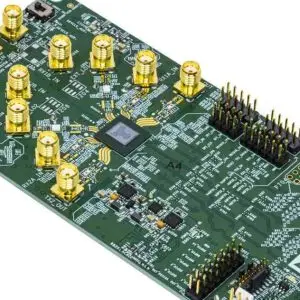The XC6SLX9-3TQG144C is a high-performance field-programmable gate array (FPGA) from Xilinx’s renowned Spartan-6 family. This versatile programmable logic device delivers exceptional performance and flexibility for a wide range of applications, from consumer electronics to industrial automation systems.
Product Specification
The XC6SLX9-3TQG144C features a robust architecture designed for optimal performance and efficiency. This Spartan-6 FPGA contains 9,152 logic cells with advanced 6-input lookup tables (LUTs) that provide superior logic density and performance compared to traditional 4-input LUT architectures.
Key Technical Specifications:
- Logic Cells: 9,152
- CLB Slices: 1,430
- Block RAM: 576 Kb total memory
- DSP48A1 Slices: 16 dedicated multiply-accumulate blocks
- Maximum User I/O: 102 pins
- Package Type: TQFP144 (Thin Quad Flat Pack, 144-pin)
- Speed Grade: -3 (fastest speed grade available)
- Operating Temperature Range: Commercial grade (0°C to +85°C)
The XC6SLX9-3TQG144C incorporates Xilinx’s advanced 45nm process technology, ensuring low power consumption while maintaining high performance. The device supports various I/O standards including LVDS, LVCMOS, and differential signaling, making it compatible with a broad spectrum of interface requirements.
Price
Pricing for the XC6SLX9-3TQG144C varies based on quantity, supplier, and market conditions. Contact authorized Xilinx distributors for current pricing information and volume discounts. The competitive cost structure of the Spartan-6 family makes the XC6SLX9-3TQG144C an economical choice for cost-sensitive applications requiring FPGA functionality.
Documents & Media
Essential Documentation:
- XC6SLX9-3TQG144C Product Brief and Datasheet
- Spartan-6 FPGA Configuration User Guide
- Spartan-6 FPGA SelectIO Resources User Guide
- Package and Pinout Information
- Power and Thermal Design Guidelines
Development Resources:
- Vivado Design Suite compatibility information
- ISE Design Suite project templates
- Reference designs and application notes
- Evaluation board documentation and schematics
All technical documentation is available through the official Xilinx documentation portal, providing comprehensive design guidance and implementation details for the XC6SLX9-3TQG144C.
Related Resources
Development Tools: The XC6SLX9-3TQG144C is fully supported by Xilinx’s comprehensive development ecosystem, including the Vivado Design Suite and legacy ISE tools for older projects.
Evaluation Platforms: Several evaluation boards feature the XC6SLX9-3TQG144C or compatible Spartan-6 devices, enabling rapid prototyping and development acceleration.
IP Cores and Libraries: Access to Xilinx’s extensive IP portfolio enhances the XC6SLX9-3TQG144C’s capabilities, including processor cores, communication interfaces, and signal processing functions.
Application Examples:
- Digital signal processing applications
- Communication protocol implementations
- Motor control and power management
- Video and image processing systems
- Industrial automation controllers
Environmental & Export Classifications
Environmental Compliance: The XC6SLX9-3TQG144C meets stringent environmental standards including RoHS (Restriction of Hazardous Substances) compliance, ensuring environmentally responsible manufacturing and usage.
Quality Standards:
- AEC-Q100 qualification available for automotive applications
- Industrial temperature grade options for extended operating ranges
- Comprehensive reliability testing and qualification programs
Export Classifications: Export control classifications for the XC6SLX9-3TQG144C comply with applicable international trade regulations. Consult current export control documentation for specific country requirements and restrictions.
Package Information: The TQFP144 package provides excellent thermal performance and reliable connectivity in a compact form factor, suitable for space-constrained applications while maintaining robust electrical characteristics.
The XC6SLX9-3TQG144C represents an ideal balance of performance, features, and cost-effectiveness, making it a preferred choice for engineers developing next-generation electronic systems requiring programmable logic capabilities.



